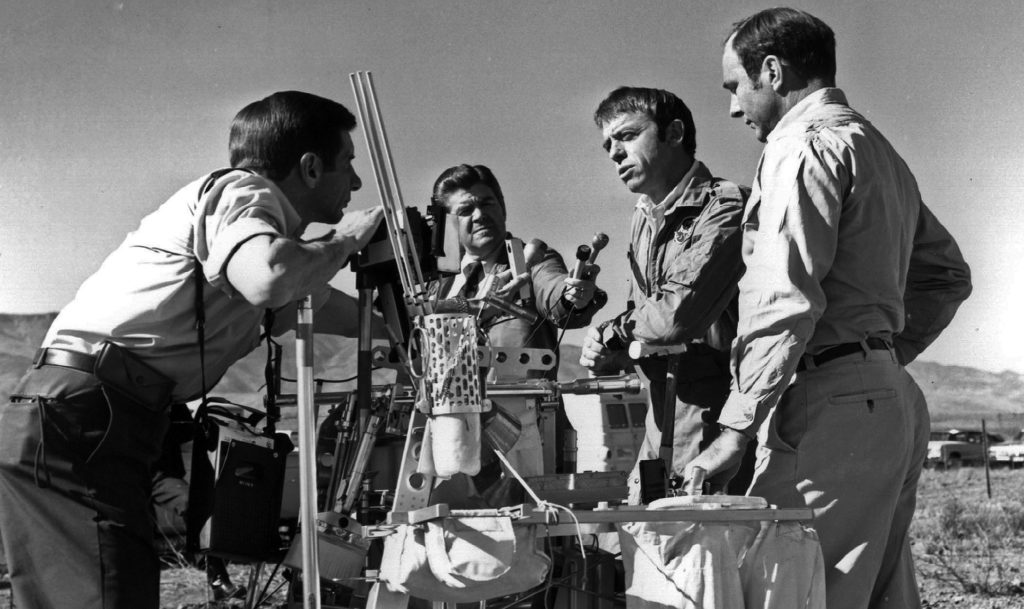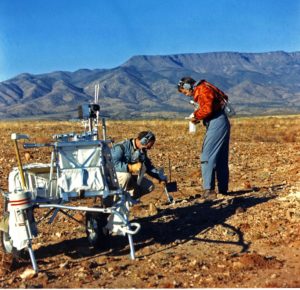
Photo: Newsman Jules Bergman (left) interviews astronauts Alan Shepard (2nd from right) and Edgar Mitchell (right) during November 1970 training at the manmade crater field near Cottonwood | Astrogeology Science Center, USGS.
By Kevin Schindler
Northern Arizona’s connections to the heralded Apollo Moon missions of the 1960s-70s run deep, as underscored in recent years by the Flagstaff Lunar Legacy celebration. Every astronaut who flew to the Moon trained here, and dozens of local scientists, engineers, and others played a role in the missions. The Lunar Legacy event celebrated this legacy and was centered around the 50th anniversary of Neil Armstrong’s historic first steps on the Moon, which he took on July 20, 1969. But six later missions also flew to the Moon, with five of them landing on the surface. One of these, Apollo 14, launched 50 years ago tomorrow.
The Apollo 14 mission is remembered for the return of Alan Shepard to spaceflight. He first rocketed into space in 1961—the first American to do so—but was then grounded for medical reasons. Now healed, he commanded the Apollo 14 mission and was joined by Edgar Mitchell and Stuart Roosa. Shepard and Mitchell would explore the lunar surface while Roosa circled overhead in the mother ship, known as the command module.

Alan Shepard (standing) and Edgar Mitchell during November 1970 training at the manmade crater field near Cottonwood | Astrogeology Science Center, USGS.
Apollo 14 was the first mission to explore the lunar highlands. These are the lighter-colored areas of the Moon, distinct from the darker, basaltic plains (mare). This was also the last Apollo mission in which astronauts walked everywhere on the lunar surface. Starting with Apollo 15, they drove exploration vehicles called rovers. This allowed them to cover much greater distances and thus explore more of the Moon.
When the Apollo 14 was nearly over, Shepard famously fashioned a golf club by attaching a six-iron head to the handle of a device used for lunar sampling. Of course he then had to try it out by hitting a few golf balls. After topping the first and slicing the second, he squarely connected on his last swing, sending the ball “miles and miles and miles”, as he crooned back to mission control.
To prepare for many of the scientific and engineering activities of the mission—if not for Shepard’s brief encounter with the lunar links—the Apollo 14 crew trained in northern Arizona (among other places). They all practiced real geology field work by visiting classic sites such as Meteor Crater and the Grand Canyon. In the latter, the ultra-competitive Shepard refused to ride a mule out, as most of his fellow trainees did. He not only hiked to the top, but made sure to be the first to reach the rim.
In the later stages of preparing for the mission, in November 1970, Shepard and Mitchell returned to northern Arizona to practice working with a two-wheeled, hand-pulled “rickshaw” they would use on the Moon to transport equipment and rock samples. They did this work at a manmade crater field a few miles south of Cottonwood. This training area was created as a cold-weather alternative to a pair of similar fields near the Flagstaff landfill, where snow filled the craters during winter months. And like the Flagstaff fields, this one still exists, though most of the craters are now filled with sediment that has washed in.
Geology wasn’t the only science on the mind of the Apollo 14 astronauts. Stuart Roosa, an outdoorsman who served as a smoke jumper earlier in his life, made many forestry-minded people happy by taking a variety of tree seeds along with him on the mission. In an account given years later in the Arizona Daily Sun, local science teacher Jim David tells of collecting some of these seeds, of Douglas fir, from the Lowell Observatory Scientific Preserve on Mars Hill.
The seeds stayed on the command module with Roosa as Shepard and Mitchell explored the lunar surface. After the mission, the United States Forestry Service germinated the seeds, most of which grew into healthy saplings. In 1976, these saplings, nicknamed “Moon Trees”, were spread around the country as part of the United States bicentennial celebration. At least two ended up in Arizona: one in Tucson on the University of Arizona campus (it still stands today, next to the Kuiper Space Sciences Building), the other in Flagstaff.
The Flagstaff tree has a bit of a sad story. A few days after this Douglas fir was planted next to what was then Flagstaff Middle School, just above Frances Short Pond, someone pulled it out of the ground. The tree died despite the best efforts of David and others to save it. The group then planted another Douglas fir in its place. That tree still stands, though its accompanying sign is badly weathered and nearly illegible. Despite this, they serve as visual reminders—along with the Grand Canyon, Meteor Crater, the manmade crater fields, and other locales—of Flagstaff’s lunar legacy.